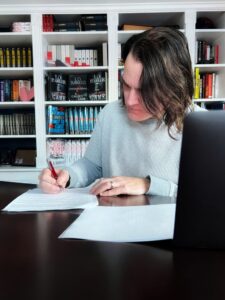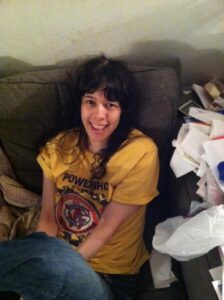by Colin Zimbleman, Ph.D. from “The Art of Autism: Shifting Perceptions” compiled by Debra Hosseini
“Here the artist’s relative lack of adaptation turns out to his advantage; it enables him to follow his own yearnings far from the beaten path, and to discover what it is that would meet the unconscious needs of his age.” C.G. Jung *
Autism is an exceptional phenomenon that has taken our cultural imagination by storm. It is exceptional because it continually eludes our definitions, expectations, and treatments, but also because it offers a chance for us to glimpse an awe-filled vision of the world that might otherwise pass us by.
Autism … offers a chance for us to glimpse
an awe-filled vision of the world that
might otherwise pass us by.
If you have been touched by or attentive to the world of autism, then, chances are, you have noticed a certain high pitch or fervor regarding this subject. Mothers of children with autism battle pharmaceutical giants. Psychologists disagree as to whether to treat this disorder from a biological or a behavioral position, and self-advocates themselves question whether Autistic Spectrum Disorder should be considered a disorder at all rather than an alternative state of being in the world.
Having worked with children on the autism spectrum, I have witnessed many of these clashing perspectives. Yet, despite the public clamor surrounding this work, what stands out above all else are the autistic person’s quiet, unexpected, and creative revelations. I have seen over and over again a capacity for profound expression that reveals an intimate and unimpeded relationship with their creative source. This takes any number of forms including writing, visual images, acting, and logic/critical reasoning – to name a few. One girl with autism, my charge in a third grade classroom, wrote this poem:
Like cosmic body glitter
So far away here on Earth
Yet so close. Flaming balls of gas.
We’ll probably never find out
How they got there.
Sky tonight,
Black or inky, velvety, raven
With a dash of peacock blue

There is another characteristic of autism that stands out and has been less widely recognized. Children with autism (and very likely adults with autism as well) seem to embody and magnify what is happening in the collective environment. I saw this while working in the third-grade classroom. The child who wrote the poem on the previous page seemed to function as an expressive conduit for what the class was experiencing but which for the most part was being contained just under the surface. In this way, persons with autism play much the same role in society, as do artists whose value lies in their ability to bring into consciousness what lies in the unconscious of the collective culture. This is why master artists have consistently challenged the status quo of their time. It is less a direct intention of the artist, but rather a by-product of their work.
Autism, too, is currently poised at the growing edge of our culture. It is a catalyst for change evidenced by the scale of the dialogue on this subject, the intensity of energy that revolves around it, and the extreme polarities of beliefs and positions taken. Artistic expression is most likely not the defining characteristic of autism. However, the fact so many of these individuals have uncanny gifts to express truths through creative work should not be overlooked. Their creativity and artwork is perhaps an appropriate metaphor for the role they play in society. Maybe it is not a coincidence the word “autistic” is so often confused with “artistic.” Like a Freudian slip, there is more to it than first appears.
* (Essay entitled, “On the relation of analytical psychology to poetry” found in the book, The Spirit in Man, Art, and Literature. Published 1966 by Princeton University Press. Trans: R.F.C. Hull.)
Colin Zimbleman received his doctorate in Clinical Psychology at Pacifica Graduate Institute in California. He is a graduate of Rhode Island Institute of Design and was Kevin Hosseini’s first art mentor. He currently works as a therapist for STAR Autism Inc. in Ventura, California.
The video below is from a news story by Rob Kunzia about Kevin and his art with Dr. Colin Zimbleman (2007).








